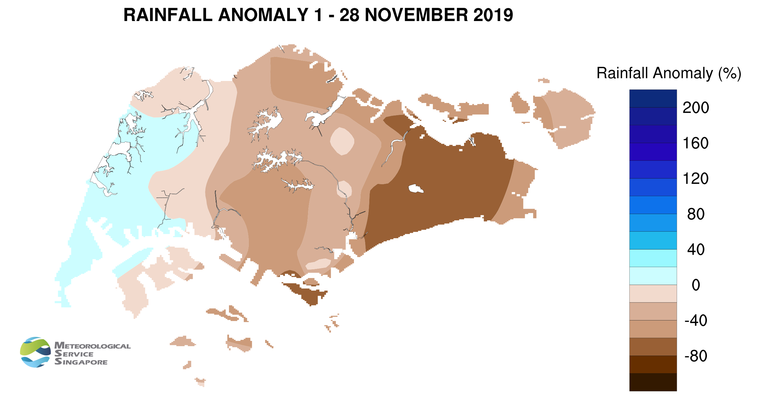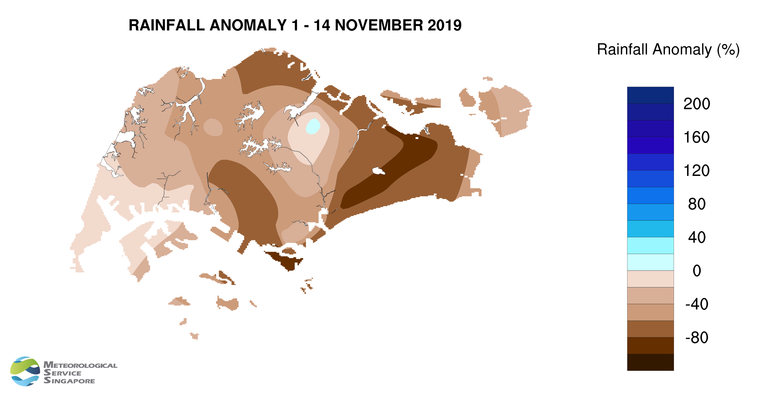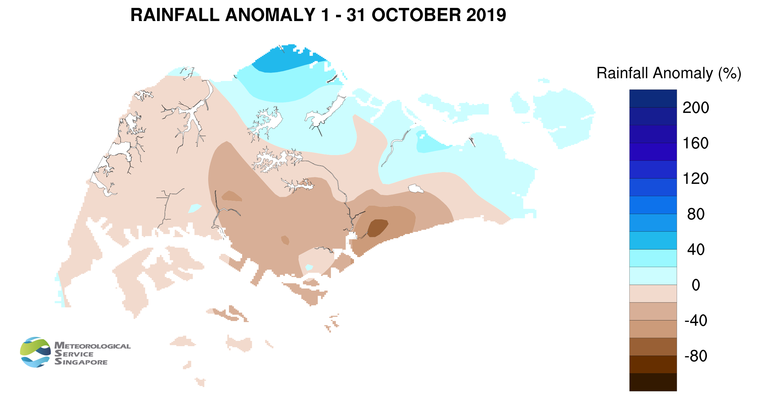Fortnightly Weather Outlook for 30 November – 15 December 2019
WEATHER OUTLOOK (30 November – 15 December 2019)
1 Singapore has been experiencing Northeast Monsoon conditions since early November 2019, and these conditions are expected to last until March 2020. During this period, the prevailing winds are forecast to blow from the north or northeast.
2 The Northeast Monsoon season has two phases, a wet phase typically between December and January and a dry phase, usually between February and March. During the first phase of the season, the monsoon rain band lies over the equatorial South China Sea, and usually brings increased cloudiness and rain showers over Singapore and the surrounding region. In addition, on occasions when there is an intensification of a high-pressure system over the northern Asian continent, this could bring a surge or strengthening of northeast winds over the South China Sea, blowing toward the equatorial Southeast Asia region. Singapore and the surrounding region can expect a few such monsoon surges[1] during the wet phase of the season, and the surge can bring several days of widespread continuous rain/showers over southern Johor and Singapore.
3 In the first week of December 2019, the southern South China Sea region including Singapore can expect a monsoon surge lasting from two to four days. The surge is likely to bring cloudy and occasionally windy conditions with periods of widespread moderate to heavy showers over Singapore. The strong northeasterly winds over the South China Sea are forecast to weaken in the second week of December 2019. For the rest of the fortnight, Singapore can expect short-duration moderate to heavy thundery showers in the afternoon on five to seven days. This is due to strong solar heating of land areas coupled with localised convergence of winds. Overall, most parts of Singapore can expect above-normal rainfall in the first fortnight of December 2019.
4 The monsoon surge event in the first week December 2019 is also expected to bring cooler daily temperatures of between 22°C and 30°C. For the rest of the fortnight, the daily temperatures are forecast to range between 24°C and 33°C, and could dip to a low of 23°C on a few nights. The daily maximum temperature could still reach a high of around 34°C on a few days.
5 For updates of the daily weather and haze situation, please visit the MSS website (https://www.weather.gov.sg), NEA website (www.nea.gov.sg), or download the myENV app, MSS’ Weather@SG app, and the haze microsite (www.haze.gov.sg).
REVIEW (1 – 29 November 2019)
5 In November 2019, the inter-monsoon conditions transitioned to the Northeast Monsoon conditions as the low-level winds which were light and variable in direction, strengthened to blow from the northwest or northeast.
6 During the month, strong solar heating of land areas coupled with localised convergence of winds led to the development of short-duration thundery showers over Singapore. The showers fell mostly in the afternoon, and on some days, extended into the evening. The thundery showers at Loyang (as at 5:31 pm) on 29 November 2019 recorded a daily total rainfall of 102.5 mm. This is the highest daily total rainfall recorded for November 2019. On that day, thundery showers fell over many parts of the island in the afternoon due to a convergence of winds over the surrounding region.
7 Although it rained across the island on most days of the month, more than half the month still recorded daily maximum temperatures of above 34°C. On 7 November 2019, the highest daily maximum temperature recorded at all stations across the island was 35.0°C at Paya Lebar on 10 Nov 2019.
8 At the climate station in Changi, the highest daily maximum temperature recorded in November 2019 (as of 28 November 2019) was 34.4°C on 17 November 2019. Based on long-term climate station records, this is 0.2°C higher than the highest ever-recorded daily maximum temperature in November on 26 November 2000. November 2019 is also likely to be on track to be the warmest November since temperature records began in 1929, with mean temperature of 28.1°C (as of 28 November 2019). This is 0.1°C above the highest record of 28.0°C in November 1998 and 2015.
9 In November 2019, many parts of Singapore recorded below-average rainfall. Sentosa recorded the highest rainfall anomaly of 79% below average while Choa Chu Kang recorded the highest rainfall anomaly of 18% above average.
[1] A monsoon surge refers to the strengthening of northeasterly winds blowing from a strong high-pressure system over the northern Asian continent toward the South China Sea, bringing periods of prolonged widespread rain and windy conditions to the surrounding region including Singapore and Peninsular Malaysia. (Further information is available at https://www.weather.gov.sg/learn_weather_systems/)
CLIMATE STATION STATISTICS
Long-term Statistics for December
(Climatological reference period: 1981 – 2010)
| Average daily maximum temperature | 30.2 °C |
| Average daily minimum temperature | 24.0 °C |
| Average monthly temperature | 26.4 °C |
| Average rainfall | 318.6 mm |
| Average number of rain days | 18 |
Historical Extremes for December
(Rainfall since 1869 and temperature since 1929)
| Highest monthly mean daily maximum temperature: | 31.6 °C (2016, 2018) |
| Lowest monthly mean daily minimum temperature: | 21.9 °C (1933) |
| Highest monthly rainfall ever recorded: | 765.9 mm (2006) |
| Lowest monthly rainfall ever recorded: | 62.5 mm (1932) |


